The state of New Mexico is home to thousands of different species, from tiny insects to gigantic bovines. We tracked down the seven biggest creatures to share with you. Some of them are relatively easy to spot, like the tarantula hawk, an insect almost as big as a small bird! In a state known for UFOs, New Mexico has quite a few natural and easily identifiable surprises waiting to be discovered. Let’s take a look at the largest animals in New Mexico!
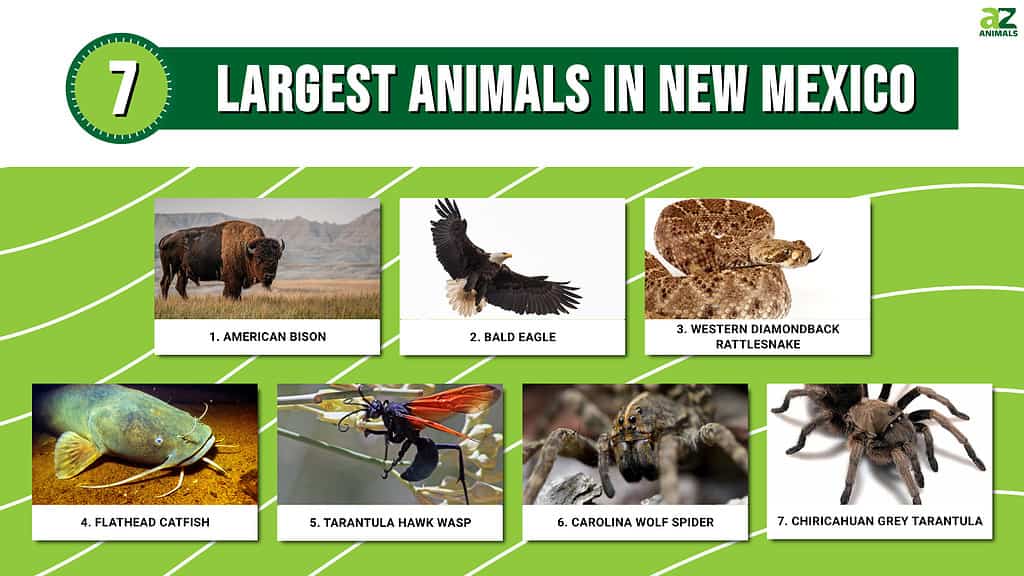
New Mexico’s Biggest Mammal: American Bison (Bison bison)
The largest animal in New Mexico once roamed the plains of North America in vast herds and numbered in the millions. In the 1950s, a few private individuals and conservation groups pushed to save what was left of the species — these shaggy behemoths were nearly extinct. The American bison is the longest and heaviest animal in North America, and the second tallest (losing first place to the moose).
Scientists have identified two subspecies: the wood bison (B. b. athabascae) and the plains bison (B. b. bison). Of the two, the wood bison is bigger, but the plains bison is more common, and they have hybridized in areas where both subspecies’ territory overlaps.
Males of both subspecies can exceed 2,000 pounds, measure over 11 feet long from head to rump, and stand over 6 feet tall at the withers. While the females are smaller, they’re no less imposing and just as dangerous.
Far from being “gentle giants,” bison are fiercely protective of their young, and very aggressive during mating season. Nearly every year, there is another report of a buffalo goring. Here are a few of the latest news reports:
- Pennsylvania woman gored by buffalo
- Trophy hunter fatally gored in groin
- Bull bison gored a man near Old Faithful
Over the last several decades, small herds were reintroduced into areas where they once roamed freely. Many of them are privately owned herds, like the one near Cimarron, New Mexico. Containing 51,000 American bison, it’s the largest private herd. In contrast, the wild herd in Yellowstone has been grazing on the same land without interruption for centuries.

American bison can exceed 2,000 pounds and measure over 11 feet long from head to rump.
©Tim Malek/Shutterstock.com
Biggest Bird in New Mexico: Bald Eagle (Haliaeetus leucocephalus)
New Mexico is home to several large birds. The biggest is the bald eagle, with an 80-inch wingspan. The bald eagle is the United States’ national bird and North America’s second largest bird of prey.
Adults of this species are unmistakable, with dark brown bodies and snow-white head and tail feathers. However, juvenile bald eagles are often mistaken for golden eagles because they don’t get their white head and tail feathers until they mature.
These birds are native to most of North America. Bald eagles are usually found near large lakes and rivers. During the winter, some spend the colder months in more southern areas, but only a few pairs of bald eagles nest in New Mexico.
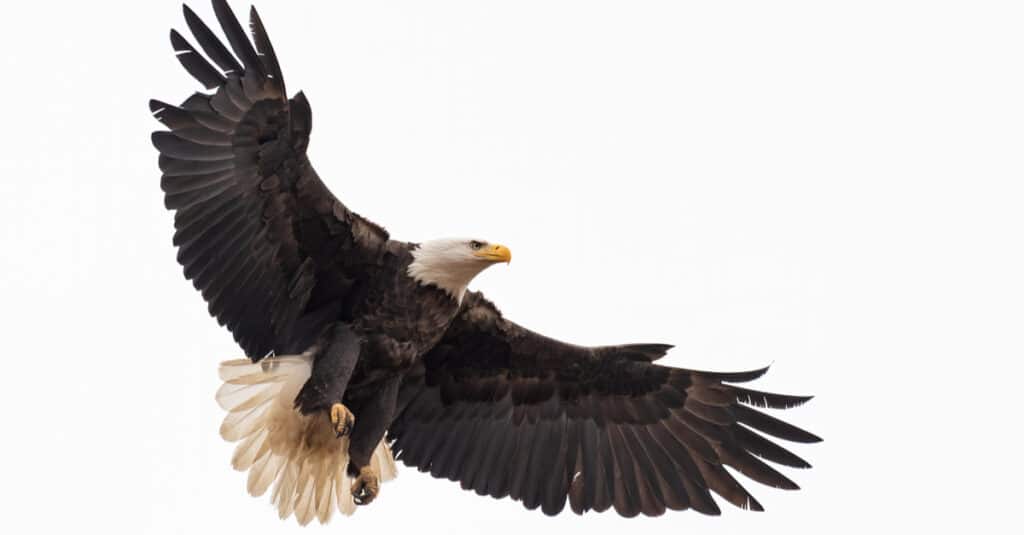
The bald eagle is the United States’ national bird and North America’s second largest bird of prey.
©Randy G. Lubischer/Shutterstock.com
New Mexico’s Biggest Snake: Western Diamondback Rattlesnake (Crotalus atrox)
The biggest snake in New Mexico also happens to be a venomous snake with a nasty reputation. The western diamondback typically averages between 4 and 6 feet long. However, they can grow to over 7 feet — the longest one on record was in Cedar Hills, Texas, and had a total length of 7.7 feet.
Fortunately for us, rattlesnakes are only fighters when they feel they’re out of options. These snakes are native to North America and Mexico, from Texas west to California. The species is flexible and adapts easily to different habitats. Western diamondback rattlesnakes can inject up to 800mg of venom in a single bite, but their venom is rarely fatal. Even an untreated bite only has a 20% fatality rate. Regardless, any rattlesnake bite is a medical emergency because the venom causes tissue death (necrosis) and can lead to internal bleeding.
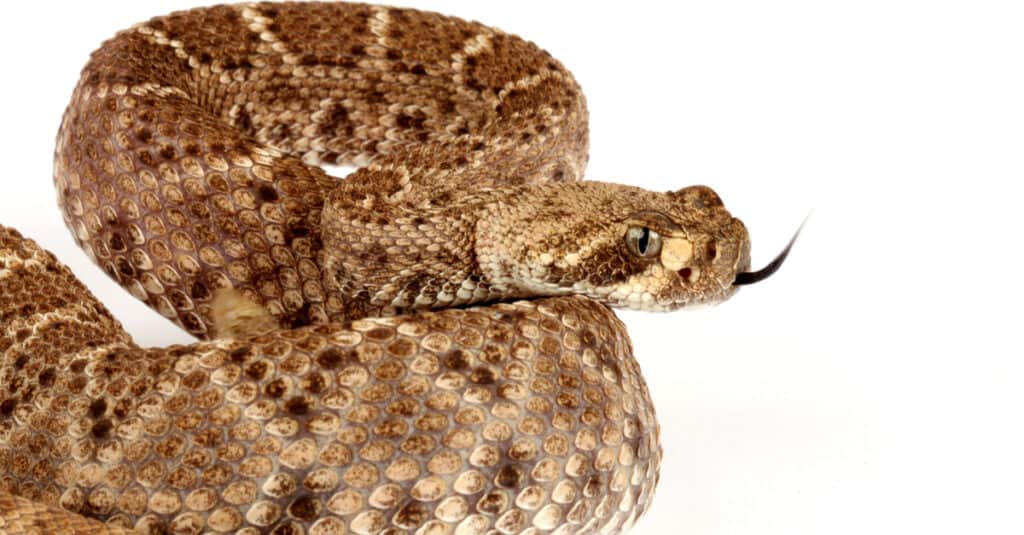
The longest western diamondback on record was in Cedar Hills, Texas, and had a total length of 7.7 feet.
©Audrey Snider-Bell/Shutterstock.com
Biggest Fish in New Mexico: Flathead Catfish (Pylodictis olivaris)
The biggest fish in New Mexico, the flathead catfish, has a wide distribution. It is found in rivers and lakes west of the Appalachian Mountains, extending north to Canada, and west to New Mexico. It can also live in salt water and tolerate less optimal conditions.
Flathead catfish can reach monstrous sizes, sometimes growing to a whopping 61 inches in length and 123 pounds. These monsters don’t always get this big, however. Flathead catfish reach maturity at 18 inches, when they are between four and five years old.
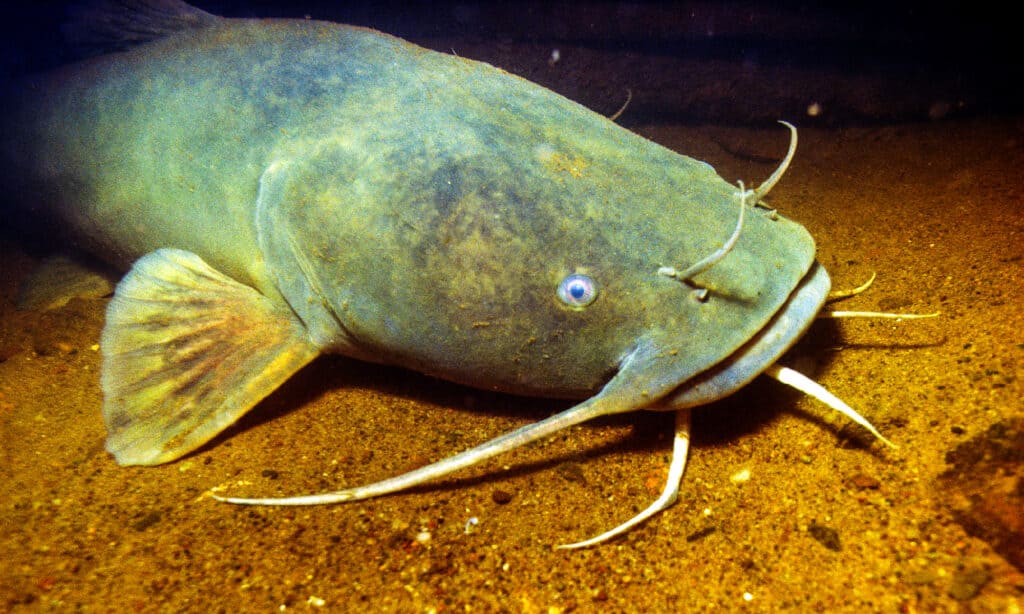
Flathead catfish can reach monstrous sizes, sometimes growing to a whopping 61 inches in length.
©iStock.com/stammphoto
Biggest Insect in New Mexico: Tarantula Hawk Wasp (Pepsis grossa)
This huge insect is New Mexico’s state insect; its body can measure up to 2 inches long. It has the second most painful sting of any insect, nearly as nasty as that of the bullet ant. Tarantula hawks are native to the southern half of North America and range as far south as northern South America.
They’re more common away from heavily urban areas because, like all predators, they follow their prey. However, only the females hunt, and they are the ones to deliver that painful sting; they are also significantly bigger than males. Tarantula hawks are almost as big as some small birds.
These predatory wasps lure tarantulas out of their burrows by damaging the entrance. Then, it kills the tarantula and lays eggs on its body for the larva to eat when they hatch. These insects seem very specific in their prey choices too — they choose large female tarantulas for the fertilized eggs and smaller male tarantulas for unfertilized eggs.

The female tarantula wasps hunt, and they are the ones to deliver that painful sting.
©iStock.com/Rainbohm
New Mexico’s Biggest Spiders: Chiricahuan Grey Tarantula (Aphonopelma gabeli) and Carolina Wolf Spider(Hogna carolinensis)
Although spiders have exoskeletons like insects, they’re not insects. Spiders are in the order Aranea with other arthropods like scorpions, collectively called arachnids. Unlike insects which only have six legs, spiders have eight legs plus a venom-injecting appendage like fangs.
In New Mexico, the two biggest spiders seem to be neck-and-neck. Both species can reach a 6-inch leg span. Though the tarantula is a heavier and more imposing spider, the Carolina wolf spider’s habit of carrying its babies around on its back gives it a creep factor on top of its size.
Carolina Wolf Spider
Carolina wolf spiders are one of over 2,000 species of wolf spiders and the most widespread in North America. They’re much more active when breeding and hunting during the spring and summer. These active spiders track down their prey rather than building a web and waiting, which is how they wind up in so many houses. The female wolf spider gets quite a bit larger than the male and she carries her spiderlings on her back. An attempt to swat this spider may result in 50 scurrying spider babies!
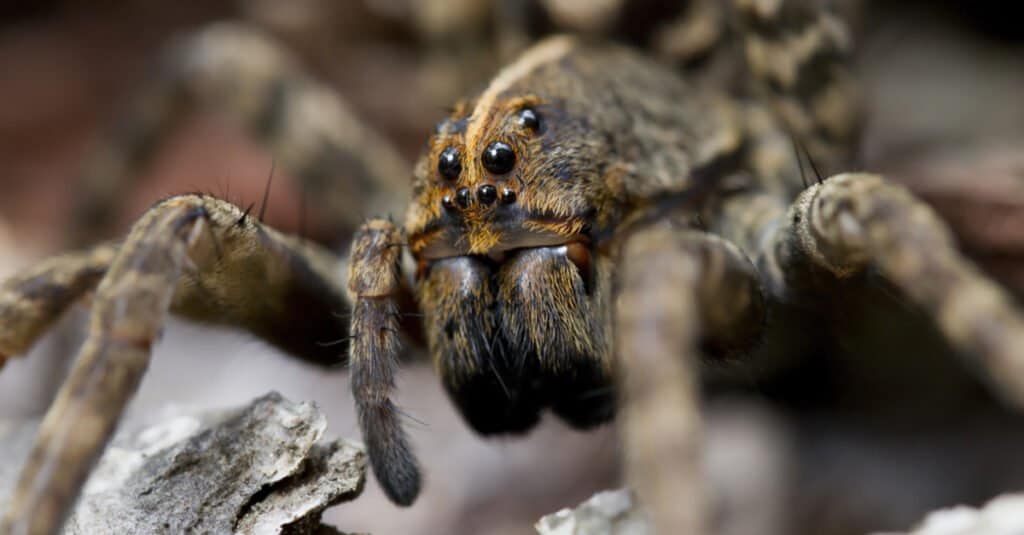
©Will E. Davis/Shutterstock.com
Chiricahuan Grey Tarantula
Tarantulas are big, heavy spiders that can move surprisingly fast. They’re found all over the world, and some are large enough to eat birds. The Chiricahuan Grey Tarantula doesn’t get quite that big, but its leg span can reach six inches.
This species is named after the Chiricahuan National Monument in Arizona. They have a reasonably wide range and are sometimes found in western Texas in addition to New Mexico. They can live 10-12 years in captivity, but usually have a shorter lifespan in the wild.
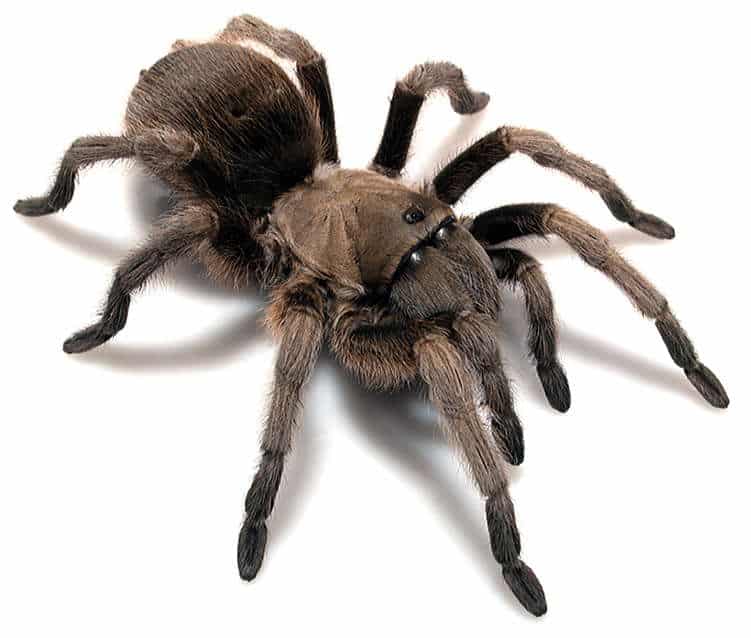
This grey tarantula species is named after the Chiricahuan National Monument in Arizona.
©Chris A. Hamilton, Brent E. Hendrixson, Jason E. Bond / Creative Commons – License
Summary of the 7 Largest Animals in New Mexico, and Where You’ll Find Them
| Type of Animal | Animal | Location | |
|---|---|---|---|
| 1 | Mammal | American Bison | Cimmaron |
| 2 | Bird | Bald Eagle | near large lakes and rivers |
| 3 | Snake | Western Diamondback Rattlesnake | various habitats |
| 4 | Fish | Flathead Catfish | rivers and lakes west of the Appalachians |
| 5 | Insect | Tarantula Hawk Wasp | southern half of North America and South America |
| 6 | Spider | Carolina Wolf Spider | all over North America |
| 7 | Spider | Chiricahuan Grey Tarantula | Western Texas and New Mexico |
The photo featured at the top of this post is © iStock.com/Sean Pavone
Sources
- Hawks Aloft (1970) Hawksaloft.com
Thank you for reading! Have some feedback for us? Contact the AZ Animals editorial team.







